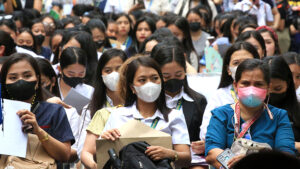




Monthly Economic Update: One for the road
 DOWNLOAD
DOWNLOAD

Inflation Update: Still low, still slow
 DOWNLOAD
DOWNLOAD

Philippines Trade Update: Exports momentum continues
 DOWNLOAD
DOWNLOAD


Philippine jobless, underemployment rates rise in January

The country’s jobless rate and job quality worsened to six-month high in January due to the loss of seasonal jobs during the holidays, the Philippine Statistics Authority (PSA) reported on Friday.
Preliminary data from the PSA’s latest Labor Force Survey showed the unemployment rate in January climbed to 4.5% from 3.1% in December. However, this was lower than the 4.8% recorded in January last year.
It matched the jobless rate logged in September and the largest since the 4.8% share in July.
This translated to 2.15 million unemployed Filipinos in January, up by 548,000 from 1.60 million in December
Year on year, the ranks of jobless Filipinos dropped by 228,000 from 2.38 million in January 2023.
PSA Undersecretary and National Statistician Claire Dennis S. Mapa expected unemployment data to rise month on month in January due to the loss of temporary jobs during the last quarter.
“The data showed were not unique. During the last quarter, there were lots of activities that helped the unemployment drop, particularly in the retail trade, such as bazaars, online selling, and stores. In January these activities stopped,” he said during the press conference.
The job quality in January deteriorated as underemployment rate went up to 13.9%, picking up from 11.9% in December. On a year-on-year basis, it was lower than 14.1% a year ago.
It was the biggest share of employed Filipinos who wanted additional hours of work at their current job, an additional job, or a new job with longer working hours to the total employed population since the 15.9% in July 2023.
In absolute terms, January’s number of underemployed Filipinos increased by 384,000 month on month to 6.39 million.
On an annual basis, it slipped by 260,000 from 6.65 million in January last year.
Likewise, employment rate inched down to 95.5% in January, lower from the 96.9% seen in December and the 95.2% in January 2023.
This was equivalent to 45.94 million employed Filipinos, lower than the 50.52 million in the previous month and 47.35 million in January 2023.
The country’s labor force reached 48.09 million in January, slipping by 4.03 million from 52.13 million in December. On a year-on-year basis, it was down by 1.64 million from 49.73 million.
This translated to a labor force participation rate (LFPR) — the share of labor force to the total population 15 years old and over — of 61.1%. This was lower than the 66.6% recorded in December and January 2023’s 64.5%.
The services sector remained the top employer in January with an employment rate of 60.2%, followed by agriculture (21.4%) and industry at (18.4%).
The average Filipino employee worked for 42.1 hours a week in January, higher than 40.6 hours in December and 39.5 hours from a year ago.
Cid L. Terosa, a senior economist at the University of Asia and the Pacific, said that unemployment and underemployment rates rose in January because January is a lean month for business and production activities.
“It is possible that those who were temporarily employed during the last quarter of 2023 to cope with brisk business and production activities have been laid off. Also, businesses are less keen on hiring people on a full-time basis at the start of the year when operations and activities are slower,” Mr. Terosa said in an e-mail interview.
“Seasonal factors have faded and now we see unemployment back to its typical high of 4.5%. We did expect this to happen. We are, however, also cautious of the El Niño impact especially for agriculture jobs,” said Union Bank of the Philippines, Inc. Chief Economist Ruben Carlo O. Asuncion said in a separate e-mail interview.
Month-on-month job losses were recorded in agriculture and forestry (down by 2.68 million), wholesale and retail trade (down by 1.22 million), construction (down by 549,000), accommodation and food service activities (down by 389,000), and manufacturing (down by 273,000).
Meanwhile, wholesale and retail trade recorded the biggest job losses annually after shedding 1.51 million employees. It was followed by agriculture and forestry (down by 854,000), public administration and defense (down by 226,000), manufacturing (down by 151,000), and information and communication (down by 49,000).
Mr. Terosa sees the jobless rate will slightly improve in February as business and production start to pick up.
“We expect jobless rate to average between 4% and 5% in the coming months amid elevated interest rate and weather-related impact on job opportunities,” Mr. Asuncion said. — By Lourdes O. Pilar, Researcher
This article originally appeared on bworldonline.com





 By BusinessWorld
By BusinessWorld
